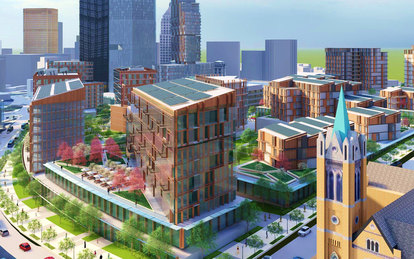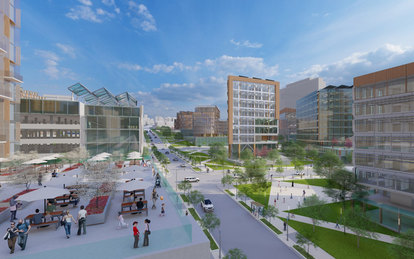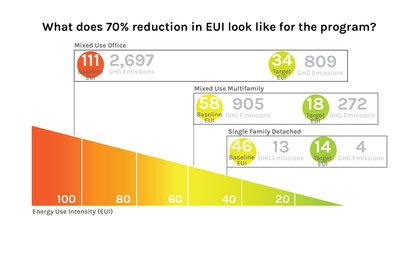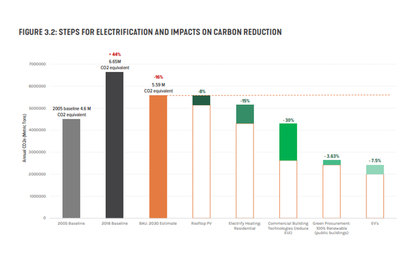Duquesne Light Company - Decarbonization Strategy and Smart Electric Energy District (SEED)
With limited control over how the electrical power they sell is generated, deregulated U.S. utilities are facing significant challenges as they work to decarbonize their energy operations to combat climate change.
Client
Duquesne Light Company
Location
Pittsburgh, Pennsylvania
Markets/Services
Architecture, Energy & Environmental Modeling, Landscape Architecture, MEP Engineering, Mixed-Use, Sustainable Design, Urban Design, Urban Environments, Urban Planning, Corporate & Commercial
Size
Grid-scale analysis applied to 28 AC site
Duquesne Light Company (DLC) is an electric utility in the Pittsburgh region serving 600,000 customers. Founded in 1912, DLC is one of the nation’s oldest electric utilities – and has long been at the forefront of navigating major changes in energy supply, demand and policy. SmithGroup worked with DLC to evaluate and develop strategies for renewable energy, distributed energy, and electrification that will help the utility advance their strong commitments to energy innovation, including equity, grid modernization, and decarbonization.
The process started with a planning study to help define the company’s pathway to decarbonization. The resulting decarbonization strategy identifies DLC’s role as transmission and distribution owners in both local and statewide decarbonization efforts, prioritizes electrification of building and infrastructure systems in concert with grid improvements, and supports internal and external stakeholder engagement efforts centered around advocacy and incentivization.

SmithGroup’s decarbonization planning study analyzed critical questions about DLC’s grid mix, provided technical and regulatory guidance for adapting their operations, and helped create a cohesive narrative around leveraging electrification to spur a larger transition away from fossil fuels.
The second phase of the work developed a key implementation strategy that DLC is using to advance electrification: the Smart Electric Energy District (SEED) model. Traditional thinking about the grid views large-scale changes in power-generation as the only way to achieve large-scale gains in energy efficiency and emissions reduction; however, recent improvements on the power distribution and management side create new opportunities for localized action with grid-scale impact.
The SEEDs approach focuses on reducing Energy Use Intensity (EUI) in commercial buildings at a district scale, and combining this with localized renewable energy generation, new storage technologies, and improvements in controls and management systems to support building electrification. The result is localized grid improvements with as much carbon-reduction potential as utility-scale changes made on the transmission side of the grid.
A localized dynamic grid offers just as much room for improvement as things like utility-scale solar.
Quote from DLC SEEDS
www.dlcseeds.com
To answer the question “What would this new model of an electrified neighborhood look like?” SmithGroup scaled up the energy performance data for individual buildings and infrastructure systems – doing applied parametric analysis for a 28-acre area of Pittsburgh experiencing high residential and commercial growth. To account for grid capacity and resiliency, this combined energy modeling was done at a peak-use district scale; the results show the potential for buildings to act as power plants by generating and storing renewable energy, and to contribute to grid-scale management strategies like peak shaving and demand response.

The SEED model district incorporates new mixed-use and multi-family typologies that balance energy use while orienting the buildings, fenestration, and open spaces to work with the local microclimate rather than against it. The development model also integrates embodied carbon reductions – analyzing for the incorporation of renewable construction materials like mass timber – as well as livability and equity considerations into its overall framework.
The SEED development model brings together all the interconnected pieces of a fully electrified, net-zero district. The outcome is a replicable decarbonization framework for urban development and redevelopment that DLC is looking to advance as pilot projects in its Pittsburgh-region service territory. It also provides an innovative new benchmark for deregulated utilities seeking to advance significant decarbonization efforts in concert with local and regional partners.
SEED’s holistic approach is extending directly into the next phase of work to assess local energy burden issues. The assessment focuses on a historically disadvantaged neighborhood in Pittsburgh to develop strategies for addressing energy equity and affordability as a foundational part of the city’s “grid of the future.”




